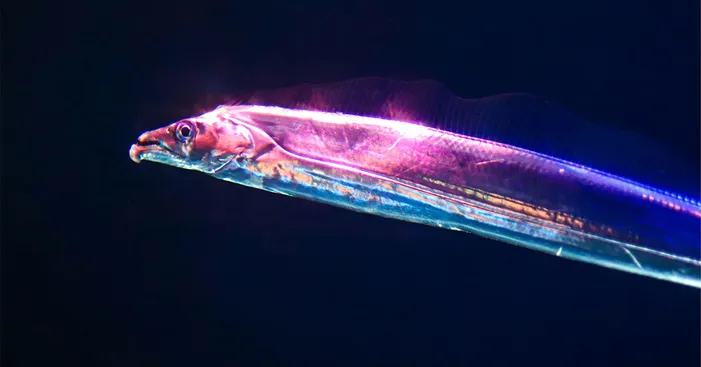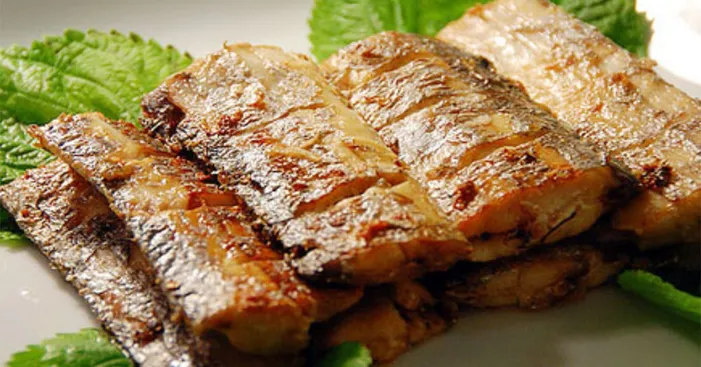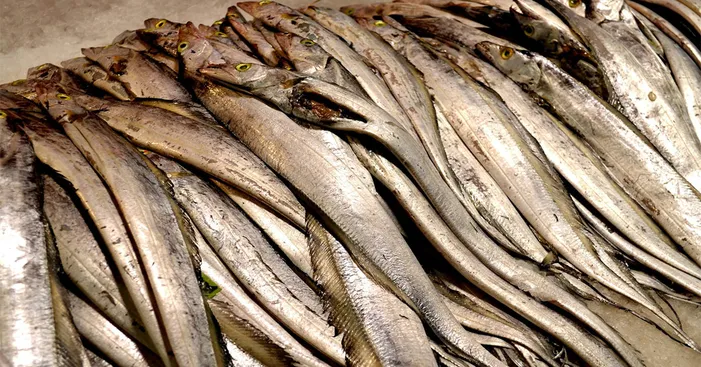Table of Contents

Beltfish is a widely caught fish in our country and is found in both the north and the south.
It is a common sight at home-cooked meals but is often excluded from the menus of high-end banquets.
This is because beltfish do not survive long after being caught.
However, from another perspective, fish that leave the sea and die can also be considered “delicate and expensive.”
Winter is the best season to eat beltfish.
It is tender and delicious and can be steamed, braised, fried, or deep-fried.
In many northern places, it is customary to serve a dish of fried or braised beltfish whenever there is a celebration at home.
At the end of each year, when people are buying groceries for the New Year, in addition to pork, beef, and mutton, they will always bring home a few silver-white beltfish.
General facts about beltfish:

Overview:
Beltfish, scientifically known as Trichiurus lepturus, is a mesmerizing creature that belongs to the cutlassfish family.
It is found in tropical and subtropical waters worldwide and inhabits coastal areas near sandy or muddy bottoms.
Beltfish have elongated, silvery bodies that taper towards the tail end and sharp teeth lining both jaws.
They are voracious predators, feeding on smaller fish and crustaceans.
Beltfish are also a good source of protein, omega-3 fatty acids, and vitamins B6 and B12.
However, it is important to consume beltfish in moderation due to its potential mercury content.
Beltfish health benefits:

A balanced Fat content:
Beltfish is a popular fish in many Asian cuisines, but it is often avoided by health-conscious diners due to its perceived high-fat content.
However, according to data, the fat content of beltfish is actually lower than that of other popular fish, such as salmon and saury.
The cooler seawater in which beltfish live does require them to have a higher fat content than fish that live in warmer waters.
However, this fat content is not excessive, and it is actually what gives beltfish its unique flavor.
In addition to its low-fat content, beltfish is also a good source of protein.
Its protein content is comparable to that of salmon and saury, making it a healthy and nutritious option for seafood lovers.
Therefore, it is fair to say that beltfish have been misunderstood as a high-fat fish.
When cooked healthily, such as grilling or baking, beltfish can be a delicious and nutritious meal.
Good sources of DHA and EPA:
DHA is essential for brain development in infants and young children, and studies have shown that eating oily fish, especially fish rich in DHA and EPA, can significantly raise HDL cholesterol levels in the body, reducing the risk of cardiovascular and cerebrovascular disease.
Additionally, people who like fish (white meat) may unknowingly consume less red meat (pork, beef, mutton, etc.) due to dietary restrictions and taste preferences, which can also help to reduce the risk of cardiovascular and cerebrovascular disease.
Low on heavy metals:
Beltfish are carnivores that eat other fish and shrimp, which means they have a higher risk of accumulating heavy metals.
However, most beltfish we eat are small, so the heavy metal content in their bodies is still much lower than that of large marine fish like beltfish, tuna, and sharks.
It is important to note that beltfish also have a high purine content, at 391 mg per 100 grams.
This means that people with hyperuricemia or gout should limit their intake of beltfish.
Cancer prevention:
Beltfish is a good source of selenium, an antioxidant mineral that plays an important role in preventing liver disease.
Studies have shown that people who consume adequate amounts of selenium have a lower risk of developing liver cancer.
Improved intelligence:
Beltfish contains omega-3 polyunsaturated fatty acids, which are essential for brain development and cognitive function.
DHA and EPA, the two main types of omega-3 fatty acids found in beltfish, have been shown to improve memory, learning, and problem-solving skills.
Beltfish is a nutrient-rich seafood that can boost cognitive function in children.
Studies have shown that children who eat more beltfish have higher IQ scores and better performance on standardized tests.
This is likely due to the high levels of omega-3 fatty acids in beltfish, which are essential for brain development.
In addition to omega-3 fatty acids, beltfish are also a good source of protein, which is essential for the growth and repair of all cells in the body, including brain cells.
Protein also helps to produce neurotransmitters, which are chemicals that allow brain cells to communicate with each other.
Cardiovascular health:
Beltfish can help to reduce blood pressure and cholesterol levels, which are two major risk factors for cardiovascular disease.
Eating beltfish regularly can also help to protect the heart and blood vessels.
In addition to the benefits listed above, beltfish are also a good source of protein, vitamins, and minerals.
It is a low-fat, high-nutrient food that can be a healthy part of any diet.
Prevented Alzheimer’s disease
Alzheimer’s disease is a neurodegenerative disorder that causes progressive memory loss and cognitive decline.
While there is no cure for Alzheimer’s disease, there are steps that can be taken to reduce the risk of developing the disease.
One of these steps is to eat a healthy diet that includes plenty of omega-3 fatty acids.
Omega-3 fatty acids are essential for brain health and have been shown to protect against Alzheimer’s disease.
Studies have shown that people who eat more omega-3 fatty acids have a lower risk of developing Alzheimer’s disease.
Beltfish is a good source of omega-3 fatty acids, so eating beltfish may help to reduce your risk of developing Alzheimer’s disease.
Promoted metabolism
The iodine in beltfish helps to maintain thyroid function.
The thyroid is a gland that produces hormones that regulate metabolism, growth, and development.
If the thyroid is not functioning properly, it can lead to several health problems, including weight gain, fatigue, and constipation.
Eating beltfish can help to ensure that your thyroid is functioning properly and that your metabolism is running smoothly.
This can help you to maintain a healthy weight and energy level.
A superfood for vital organs:
Beltfish is a delicious and nutritious fish that is packed with health benefits.
It is a good source of selenium, omega-3 fatty acids, and protein, all of which are essential for good health.
Selenium is an antioxidant mineral that helps to protect cells from damage.
It is also important for liver function and thyroid health.
Omega-3 fatty acids are essential for brain development and cognitive function.
They also help to reduce inflammation and improve heart health.
Protein is essential for muscle growth and repair.
Beltfish is a low-fat, high-nutrient food that can be a healthy part of any diet.
It is especially beneficial for people who are at risk of developing cancer, heart disease, or liver disease.
So next time you are looking for a healthy and delicious meal, reach for beltfish!
Precautions before consuming beltfish:

Beltfish are delicious and nutritious seafood, but there are a few precautions to take when eating them.
First, avoid frying beltfish with butter or mutton fat, as this can make them difficult to digest.
Second, do not eat beltfish with raw peanuts, as this can cause stomach upset.
Third, steer clear of eating beltfish with licorice or nepeta, as this can cause the fish to move while you are eating it.
Additionally, the silver scale membrane on the body of the beltfish is nutritious, so avoid scraping it off.
Finally, beltfish are rich in fat, especially on the body surface.
Fat is easily oxidized in the air, so beltfish that have turned yellow are spoiled and should not be eaten.
Using beltfish:

Beltfish is a firm, tasty white fish that is often sold in fillets or sections.
It is a popular choice for cooking because it is easy to prepare and has virtually no bones.
This makes it a great fish for children to eat.
Beltfish fillets are perfect for rolled preparations, such as paupiettes de la mer (fish paupiettes).
Paupiettes de la mer are made by surrounding a fillet with a stuffing of small vegetables and then closing it with string or a wooden pick.
They are simple to prepare with a few spices and olive oil, and can also be cooked en papillote (in parchment paper) or pan-fried until golden brown.
Beltfish pairs well with creamy sauces or meat products for tasty land-sea recipes, such as sabre with chorizo.
It is also a popular ingredient in Portuguese cuisine and is commonly found on the island of Madeira, where it is known as Espada.
Espada is traditionally served a la delicia with pieces of fried banana, but can also be served fried, filleted, or with slices of passion fruit.
Beltfish Soup with Astragalus:

Ingredients:
- 500 grams beltfish
- 30 grams astragalus
- Cooking wine
- Refined salt
- Green onion
- Ginger
- Light soy sauce
Preparation:
- Wash the astragalus and place it in a gauze bag. Tie the mouth of the bag closed.
- Clean the beltfish by removing the scales and internal organs. Cut it into 10 cm segments and rinse.
- Heat some oil in a pot and fry the beltfish until lightly browned.
- Add the astragalus bag, cooking wine, salt, green onion, and ginger to the pot.
- Add enough water to cover the beltfish and bring to a boil.
- Reduce the heat to low and simmer until the beltfish is cooked through.
- Remove the astragalus bag and discard.
- Taste and adjust the seasonings as desired.
Buying Beltfish:

When buying beltfish, it is important to choose it carefully, as stale beltfish are prone to producing histamine and other harmful substances.
If ingested in large quantities, this can lead to histamine poisoning and various symptoms of physical discomfort.
To assess the freshness of beltfish, look at the eyeballs.
The eyes of fresh, high-quality beltfish are clear and transparent, with a slightly convex appearance.
The eyes of stale beltfish, on the other hand, are cloudy and do not protrude.
You can also feel the texture of the fish’s skin to determine its freshness.
Fresh beltfish have less mucus on their skin and the scales are complete and smooth.
Unreliable beltfish have more mucus on their bodies and the scales are relatively loose.
